Easy Refrigerator Pickles
This easy recipe for refrigerator dill pickles makes it simple to enjoy crisp, tangy, homemade pickles without any special equipment or complicated steps. All you need are some fresh cucumbers and a handful of basic ingredients you probably already have in your kitchen. This is pickling made easy. No canning. No boiling jars. No fuss!
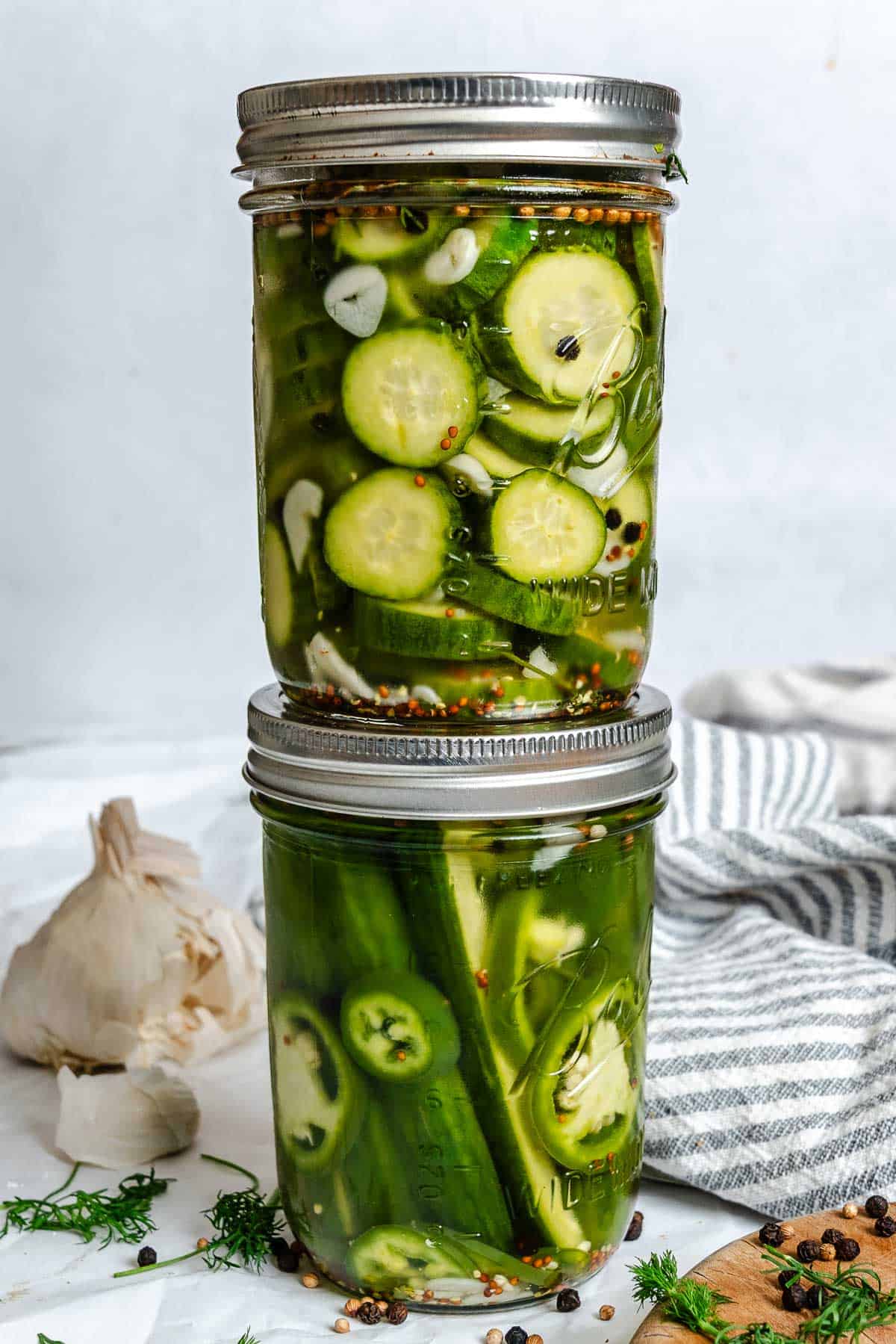
I absolutely love pickles and we always have a jar in the fridge. In the summer, I make a batch almost weekly with all of the cucumber plants growing in our garden.
Pickles vegetables are some of the easiest and most versatile food projects to make at home. With not much effort, you can have a pickled veggie that is preserved and ready to enjoy on its own, or as a punchy companion to everything from burgers to sandwiches to salads.
If it's your first time making anything pickled, don’t worry. I’ll guide you through the whole process step by step, and before you know it, you’ll have a batch of crunchy, flavorful gherkins waiting in your fridge!
You can make pickle chips or spears, but really, any firm vegetable can be turned into a batch of seriously good pickles.
Once you master this refrigerator pickle recipe, you’ll never reach for store-bought again! They're the best pickles you'll ever taste!
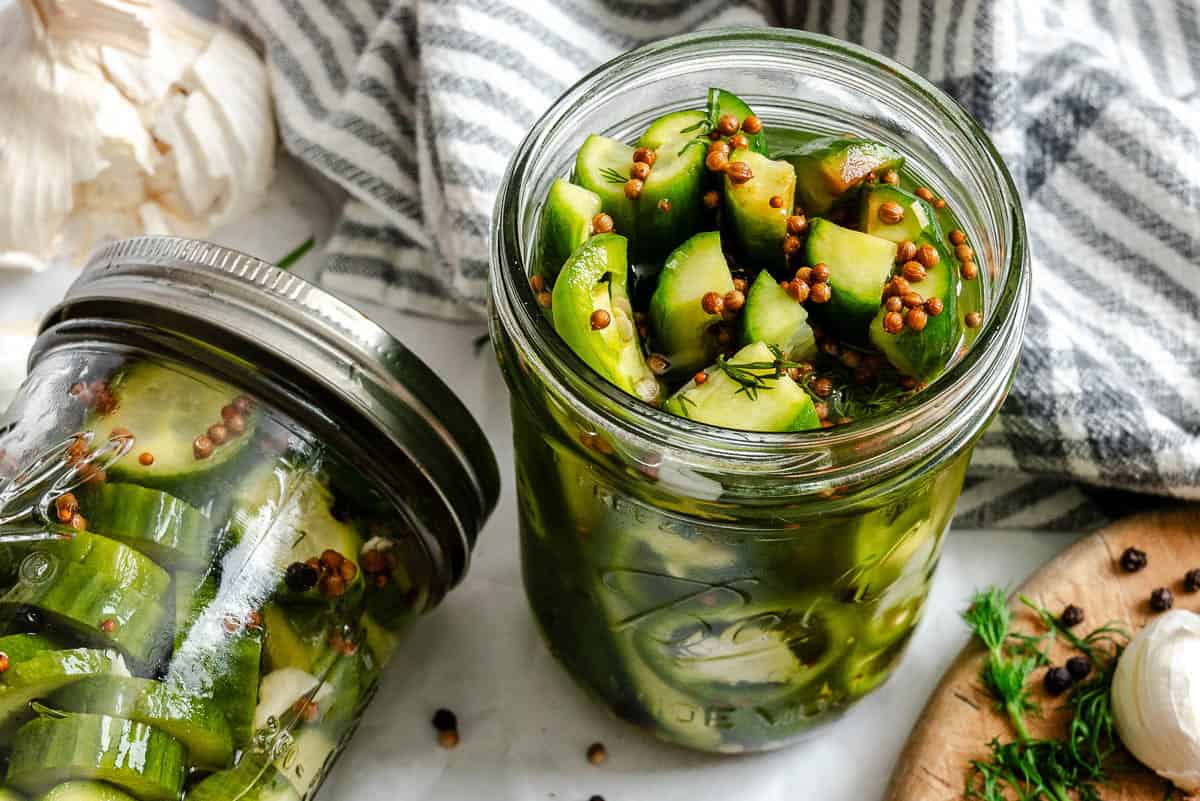
What are Refrigerator Pickles?
Refrigerator pickles are a quick pickles method that skips the traditional water bath canning process. Instead of sealing jars for pantry storage, these pickles are kept in the fridge, hence the name.
You simply combine water, vinegar and seasonings to make a pickle brine, pour it over cucumber slices (or other vegetables), and store them in a clean jar until they’re tangy and crisp.
This pickling method is great for beginners because it doesn’t require special equipment like pressure canners or vacuum sealers.
The best part is that cucumber pickles are ready to eat by the next day (or even within a few hours) and last for weeks in the fridge!
Want more cool cucumber recipes? Try my refreshing cucumber melon salad, creamy cucumber radish salad, or an easy tzatziki dip for snacking.
Why This Recipe Works
- An easy homemade pickles recipe that's endlessly customizable.
- The pickling brine works well on all kinds of vegetables, like green beans, carrots, onions, zucchini, and more.
- It skips the canning process, making it accessible for first-timers and perfect for small batches.
- This method ensures crunchy pickles every time without needing to boil jars or use high heat.
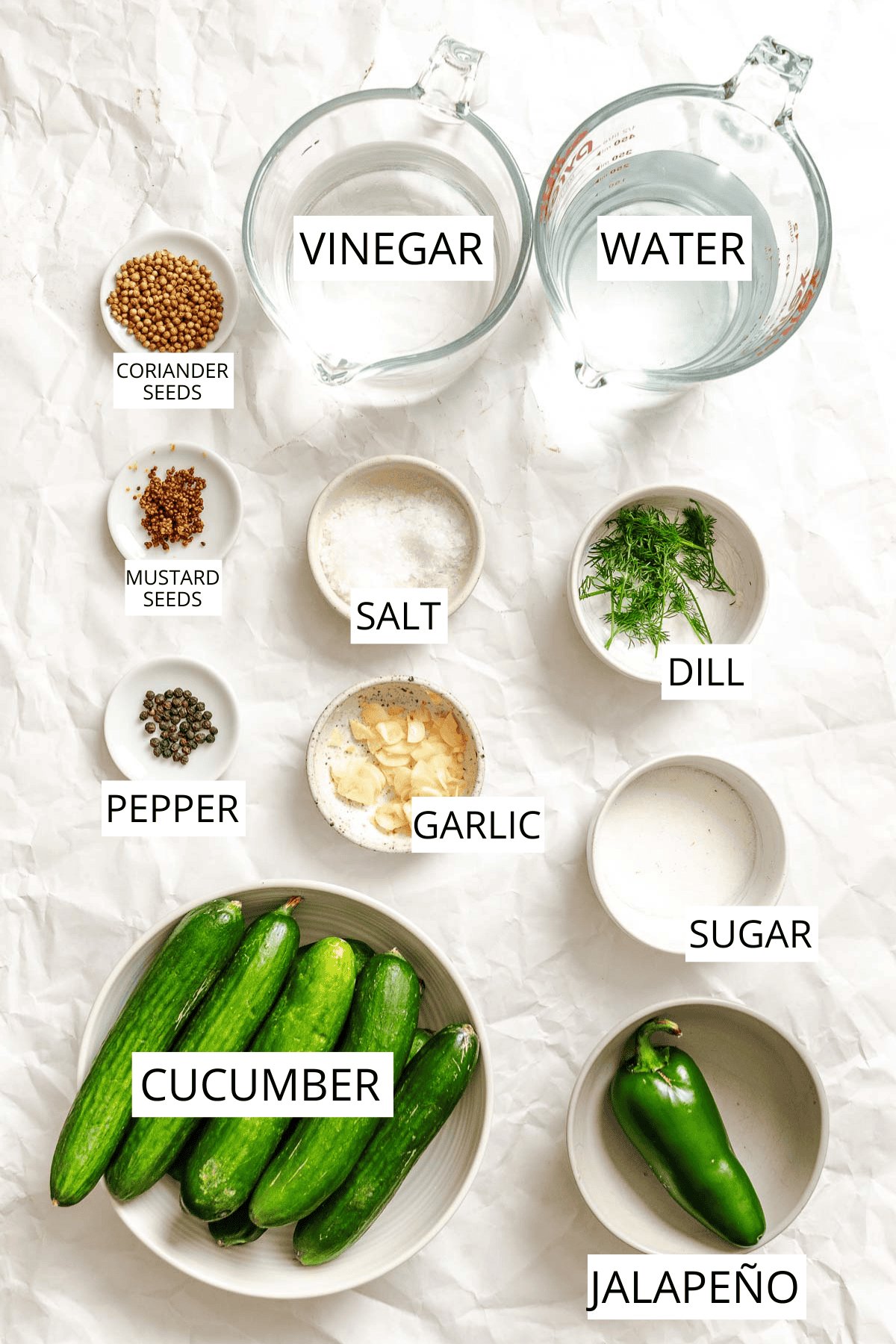
Refrigerator Pickles Recipe Ingredients
Best Cucumbers for Refrigerator Dill Pickles
The kind of cucumber matters. Kirby cucumbers are the best choice for crunchy pickle spears thanks to their firmness and small size. English cucumbers or Persian cucumbers also work, especially if you're aiming for thin, delicate slices. Be sure to peel and deseed larger cucumbers.
White vinegar - This is the most neutral and clean-tasting vinegar. It won’t discolor your pickles like dark vinegars such as balsamic or sherry vinegar. Apple cider vinegar or white wine vinegar are good alternatives if you want a fruitier or softer flavor.
Garlic - Use whole fresh garlic cloves for a strong, pungent bite. I like to thinly slice it, but you can also use whole garlic cloves. Garlic may turn blue or green from the acidity, but don't worry, it's totally normal and safe to eat!
Dill - Fresh dill sprigs are best for that signature flavor, but dried dill or even a teaspoon dill seed can work in a pinch.
Spices - A combination of mustard seeds, coriander seeds, black peppercorns and a bay leaf makes for really delicious pickles.
Salt - Use kosher salt, canning salt, or pickling salt. Avoid table salt, which can cloud the brine and be overly salty.
Jalapeños - Optional, but they make excellent spicy pickles. Add more or less depending on your heat tolerance.
*Find the full ingredient list in the recipe card below!
Helpful Equipment
- Mason jars (Quart jar or Pint jars)
- Medium saucepan
- Sharp knife
- Measuring cups and measuring spoons
How to make Refrigerator Pickles


- Combine the vinegar, cups of water, sugar, and kosher salt in a medium saucepan. Bring to a boil, stir until dissolved, then remove from heat.
- Prep and chop all of your ingredients.
Pro Tip: This is your pickle brine. Feel free to adjust sugar and salt levels to suit your taste!
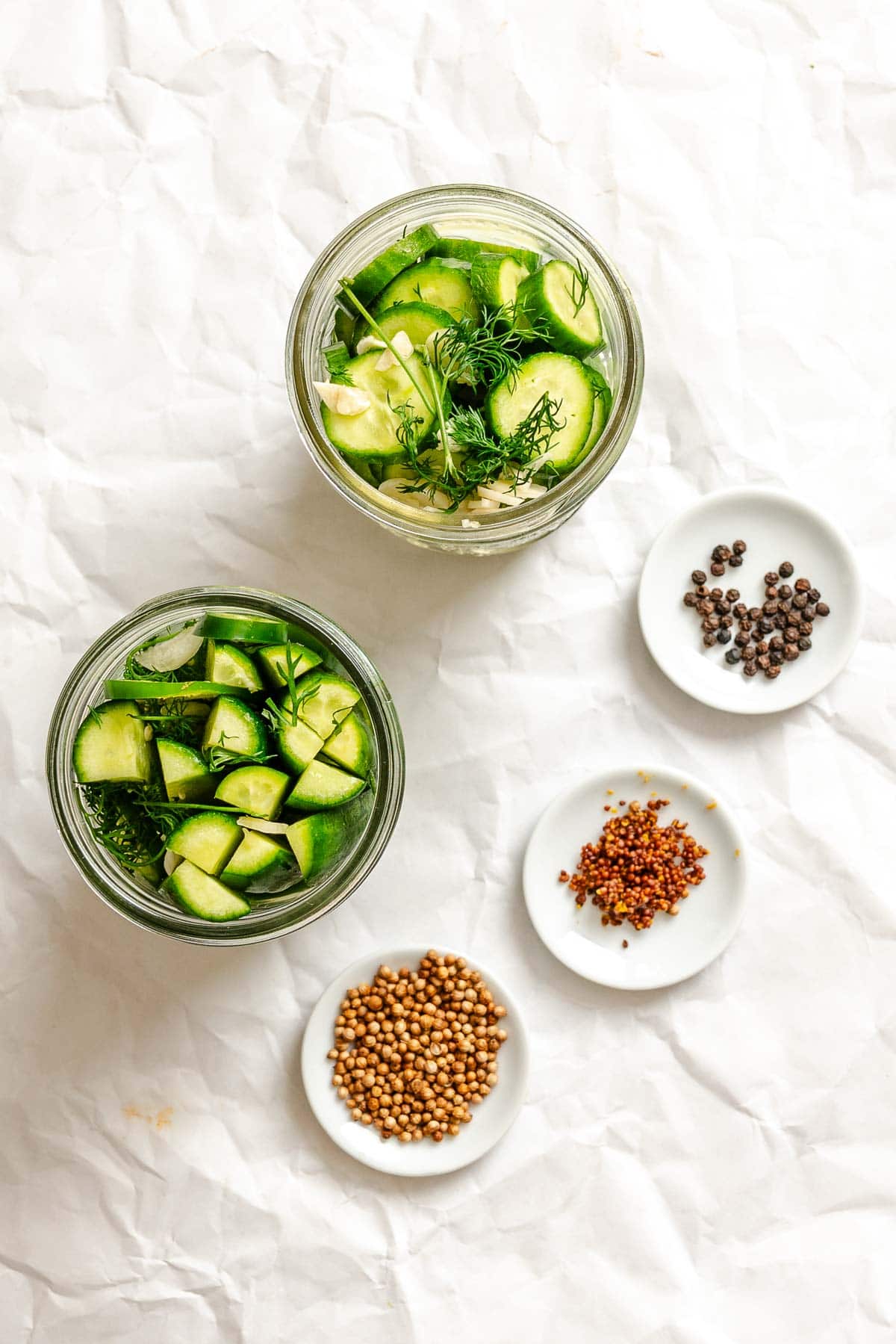
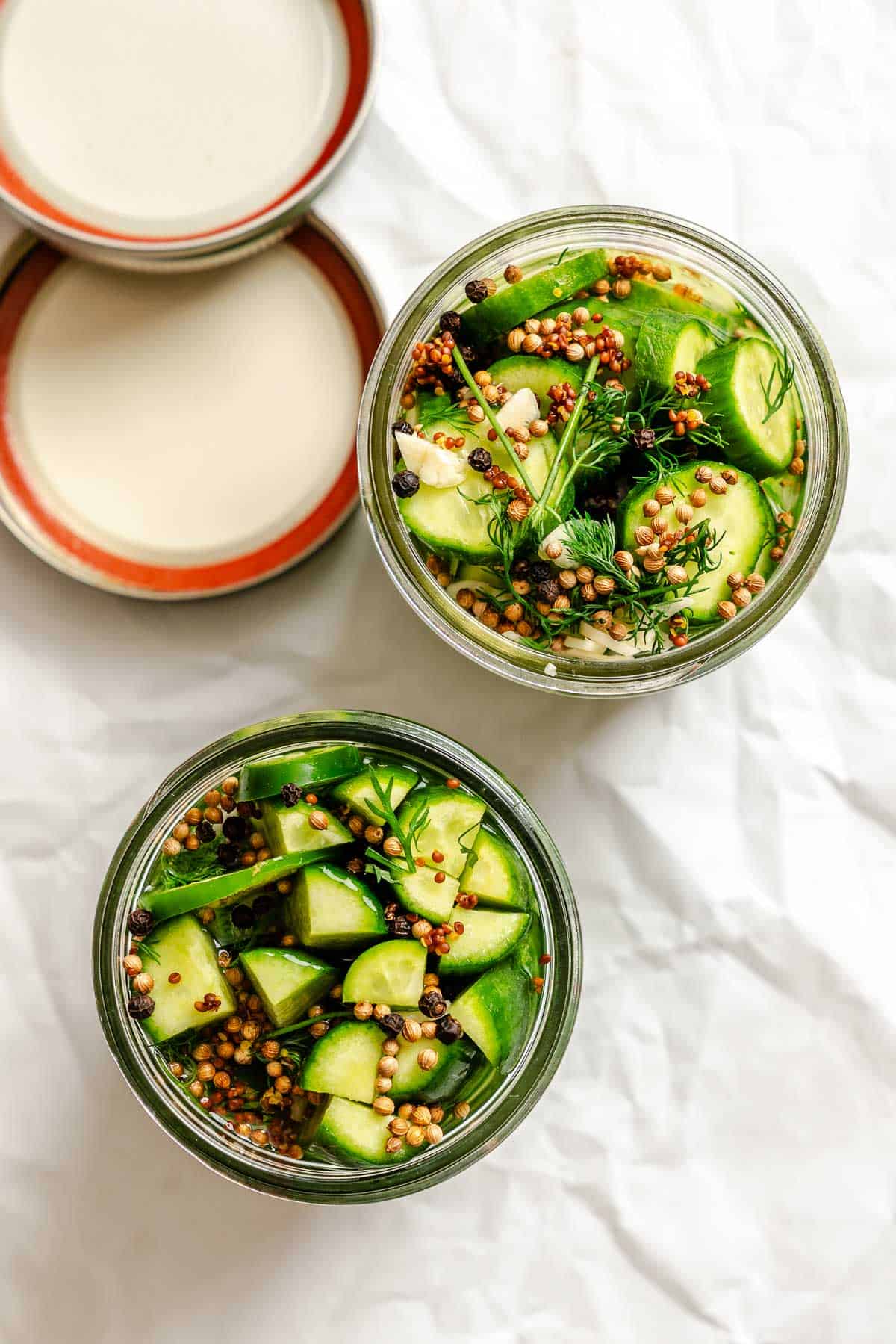
- Layer cucumber spears or slices, garlic, jalapeños (if using) and fresh dill sprigs in two quart-sized jars. Sprinkle with coriander seeds, mustard seeds and black peppercorns.
- Once the hot brine has cooled slightly, pour it over the vegetables in each mason jar. If needed, top off with cold water to cover completely.
Pro Tip: The brine should still be warm but not boiling. This helps maintain crisp pickles and prevents overcooking.
- Seal with lids and give the jars a gentle shake. Allow them to cool to room temperature, then refrigerate. Pickles will be ready in 2-3 hours, but are best the next day. Store in the fridge for up to a month.
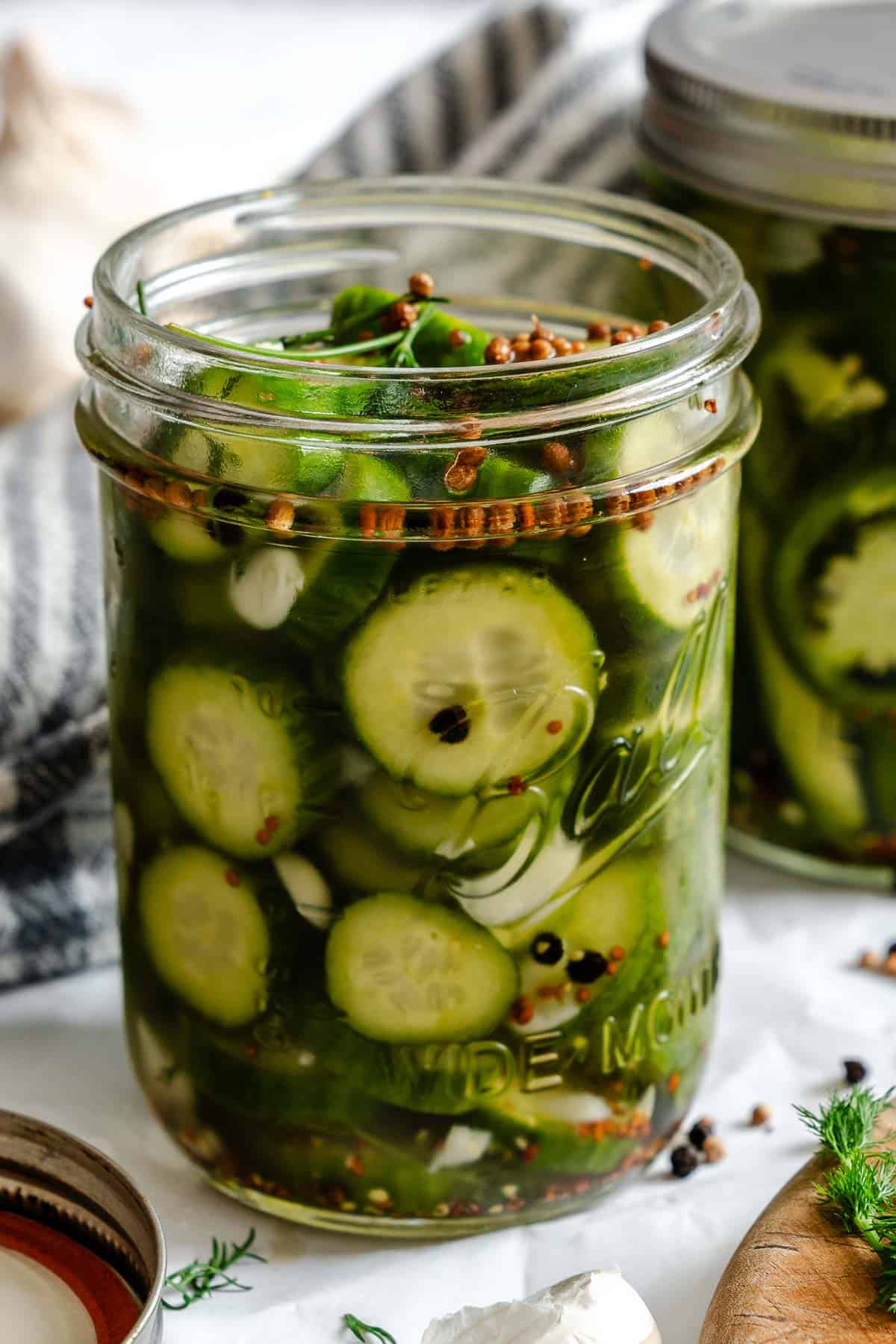
Tips for making Easy Refrigerator Pickles
- Let the pickle brine cool slightly before pouring to preserve the crunchy dill pickles texture.
- Pickle juice makes a great addition to salad dressings, marinades, or even cocktails. Don’t toss it!
- The flavor of the brine will infuse the vegetables, so make sure it tastes exactly how you want your pickles to taste. Adjust the ratios until you find your ideal homemade pickle recipe.
- Always start with a clean jar and make sure vegetables are fully submerged to avoid spoilage.
Variations
- Swap cucumbers for green beans, cauliflower, zucchini, carrot sticks, or bell peppers.
- Use apple cider vinegar or white wine vinegar for a twist on the flavor profile.
- Add a pinch of celery seed, whole cloves of garlic, or more red pepper flakes for a bolder batch.
- Make a second batch with the leftover pickle juice. Just boil and strain it first.
Serving Suggestions
These easy refrigerator dill pickles are great as a snack, on sandwiches and as a side.
Pile them on a juicy bacon cheddar burger or tuck into crispy shrimp po’boy sandwiches. It's a great recipe to serve alongside the best ever BLT's, my flaky panko crusted fried fish or this melty French onion grilled cheese.
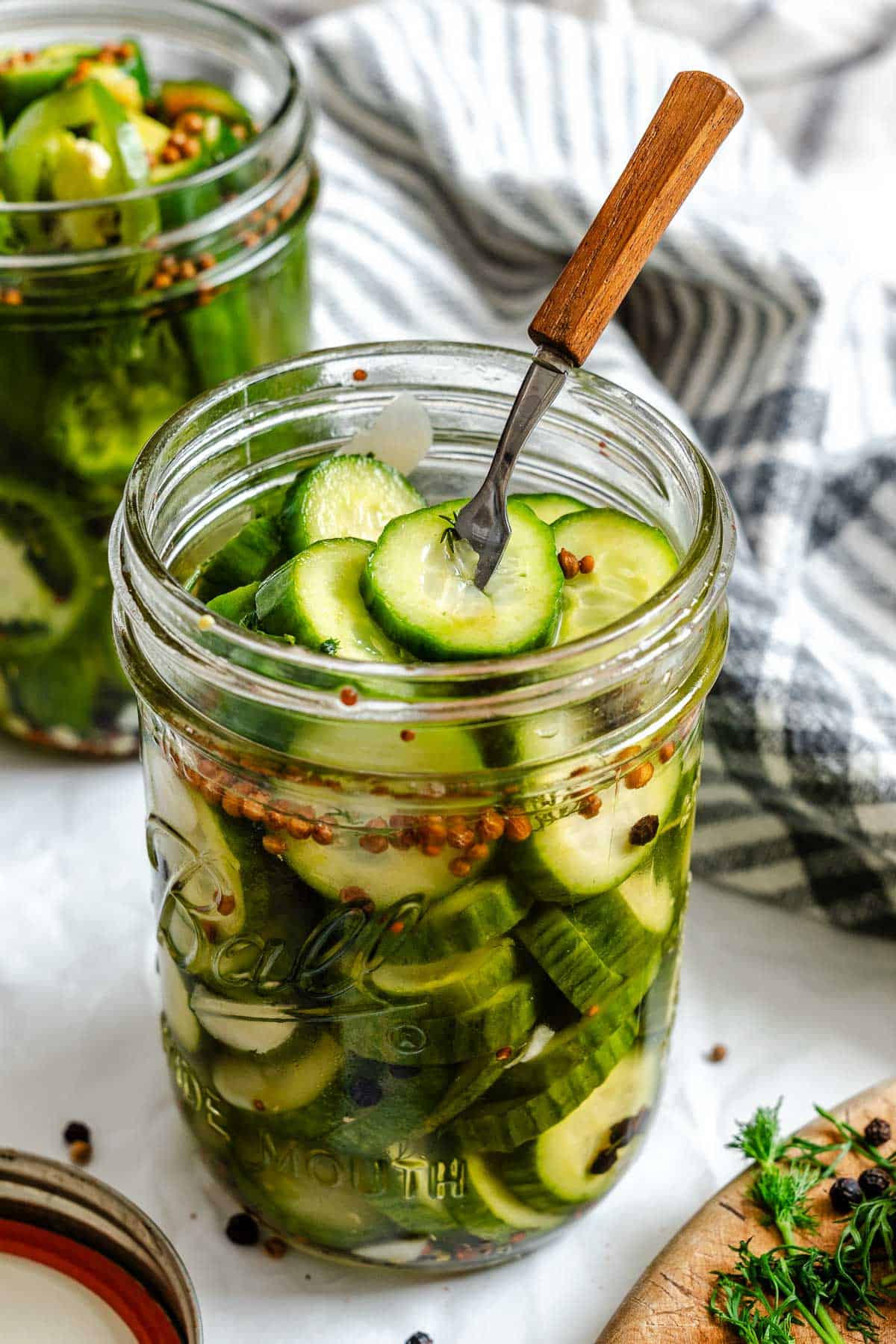
How to Store Refrigerator Dill Pickles
How long do Refrigerator Pickles Last?
These homemade refrigerator pickles will retain their fresh tangy crunch in the fridge for up to a month. Just make sure the veggies are always fully submerged in brine and stored in tightly sealed canning jars.
Can you freeze Refrigerator Pickles?
Freezing isn’t recommended. It changes the texture and creates soggy pickles. Stick to fridge storage for the best fresh pickles with crunch.
FAQs
Yes! You can reuse the pickle brine for a second batch—just bring it to a boil first to refresh it and kill any bacteria.
While mason jars or quart jars are best, you can use any food-safe container. Just make sure it's non-reactive and seals well for these easy dill pickles.
Sterilizing isn’t required in this easy recipe, like it is for canned pickles, but a clean jar and tight-fitting lid are important for safety and freshness.
Absolutely. The best thing about this refrigerator dill pickle recipe is that brine is fantastic for tasty pickles made with carrots, green beans, and more. Cut them to size and follow the same method.
Making your own homemade dill pickles means you control the flavor and ingredients, unlike the often overly processed versions from the grocery store. They’re fresher, crisper and even better when made with produce from a local farmer’s market.
Did you LOVE this recipe? Please leave a star ⭐️ rating and comment and tag your creations @ColeyCooks on Instagram!
Want to Save This Recipe?
Enter your email & I'll send it to your inbox.
By submitting this form, you consent to receive emails from Coley Cooks.
Refrigerator Pickle Recipe (No Canning)
Ingredients
Basic Brine
- 1 ½ cups white vinegar sub white wine vinegar
- 1 ½ cups water
- 1 tablespoon sugar
- 2 tablespoons kosher salt
Dill Pickles
- 6-8 small kirby cucumbers sliced ½ inch thick or into spears
- 1-2 jalapeño peppers thinly sliced, optional
- 2 cloves garlic thinly sliced
- 6 sprigs fresh dill
- 1 tablespoon coriander seed
- 1 teaspoon mustard seed
- ½ teaspoon black peppercorns
Instructions
- Combine the vinegar, water, sugar and salt in a medium saucepan and bring up to a boil. Stir until the salt and sugar have dissolved, then remove from the heat.
- Layer the cucumbers, garlic, jalapeños (if using) and dill in two quart sized jars. Sprinkle the coriander seed, mustard seed and black peppercorns evenly over the top.
- When the liquid has cooled slightly, pour it over the cucumbers. Add more cold water to cover the cucumbers completely, as needed.
- Place the tops on the jars and give them a gentle shake. When the jars have cooled to room temperature, place them in the refrigerator. They will be ready in 2-3 hours, but will get more briny over time. They last in the refrigerator for up to a month.
Notes
- Let the pickle brine cool slightly before pouring to preserve the crunchy dill pickles texture.
- Pickle juice makes a great addition to salad dressings, marinades, or even cocktails. Don’t toss it!
- The flavor of the brine will infuse the vegetables, so make sure it tastes exactly how you want your pickles to taste. Adjust the ratios until you find your ideal homemade pickle recipe.
- Always start with a clean jar and make sure vegetables are fully submerged to avoid spoilage.
Nutrition
This post may contain affiliate links.

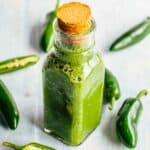
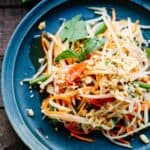
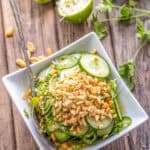
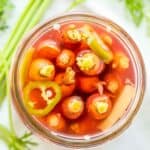
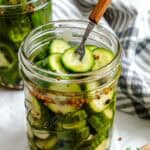
I grew persian cukes for the first time this year and wanted to try pickling. This simple recipe worked like a charm on my first try.. The pieces of vidalia onion used for flavoring turned out to be as good as the cuke slices.
Do you think it would work for Japanese eggplant?
Thanks!
I've never pickled eggplant myself but I say give it a try! Im glad you enjoyed the recipe.
Do you have to use glass jars? I'm just asking since I am not going to process them like you do when you're doing canning Can I use sturdy heavy duty plastic containers with screw on tops?
No, definitely not! Any vessel that keeps the vegetables submerged in liquid will work.
do we need to sterilized and make sure lid is tight like you do when you can tomatoes?
If you plan on canning these to store at room temperature, yes. But if making refrigerated pickles it is not
What about carrots? can we pickle them with this recipe? would that be good?
absolutely! carrots are one of my absolute favorite veggies to pickle!
lol 54 years old I have my first taste of pickled cucumbers and like very much non christian to make my own me your recipe
I've never tried making my own quick pickles before.. so thanks for the awesome idea!